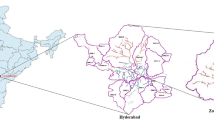Abstract
During urban development, the land surface is changed from undisturbed soils with natural vegetative cover to disturbed soils, managed landscapes, and built materials [2]. The change in land uses causes the stormwater runoff from impervious areas to be as much as 16 times higher than from natural areas [5] which implies increase of frequency of local flooding and more contribution to the streams carrying urbanized runoff. The main streams in the periphery of city Chandigarh, India are Patiali ki Rao and Sukhna Choe. This study focuses on the identification and development of a real time model for prediction of increase in stormwater runoff to the streams and within the watershed of Chandigarh due to urbanization. The study has undertaken hydraulic modeling of Sukhna Choe using United States Army Corps of Engineers Hydraulic Engineering Centre River Analysis System (HEC-RAS) to understand the urgent need of control of stormwater runoff to deal with flooding issues of the city. It has been concluded from this study that the condition of streams has been deteriorating from past to present to future condition of development and the predicted HEC-RAS water surface elevations can be put into effect to plan further development in the city.
Similar content being viewed by others
References
Brunner, G.W., HEC-RAS user’s manual, U.S. Army Corps of Engineers, California, USA, 2010.
Han, W.S. and Burian, S.J., Determining effective impervious area for urban hydrologic modeling, J. Hydrol. Eng., 2009, vol. 14, no. 2, pp. 111–120.
Lee, J.G. and Heaney, J.P., Estimation of Urban Imperviousness and its Impacts on Storm Water Systems, J. Water Resour. Planning Management, 2003, vol. 129, no, 5, pp. 419–426.
Ramasastri, K.S., Brar, A.K., and Rathore, D.S., Flood Studies in Satluj Basin, Roorkee, India: National Institute of Hydrology, 1998.
Thurston, H.W., Goddard, H.C., Szlag, D., and Lemberg, B., Controlling storm-water runoff with tradable allowances for impervious surfaces, J. Water Resour. Planning Management, 2003, vol. 129, no. 5, pp. 409–418.
Author information
Authors and Affiliations
Corresponding author
Additional information
The article is published in the original.
Rights and permissions
About this article
Cite this article
Malik, U., Kalra, A.M. Delineation of floodplains of streams to combat natural (flood) hazard in an urbanized watershed. Water Resour 44, 16–22 (2017). https://doi.org/10.1134/S0097807817010195
Received:
Published:
Issue Date:
DOI: https://doi.org/10.1134/S0097807817010195




